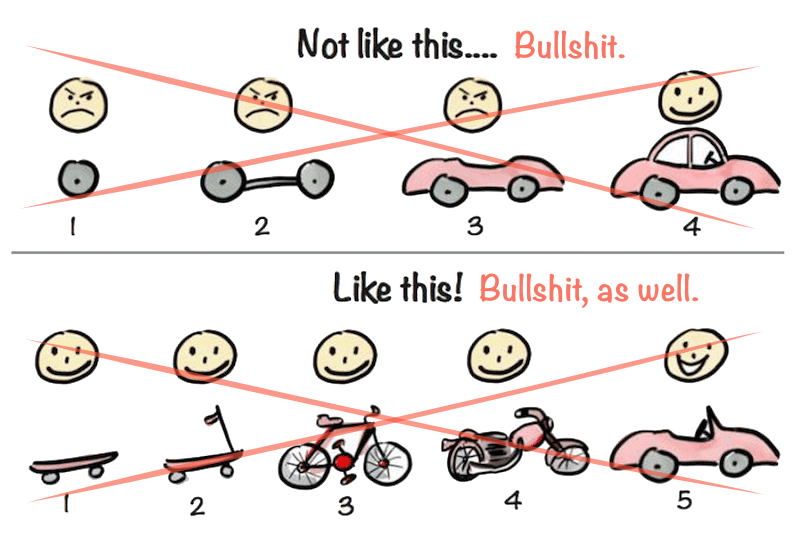 Some time ago, I saw this beautiful inspirational image on Twitter that told inexperienced entrepreneurs and product managers how they should approach the development of their products. It had hundreds of retweets and likes yet there is something fundamentally wrong with it. To be honest with you, this image is a piece of shit and it shouldn’t have been shared at all.
Some time ago, I saw this beautiful inspirational image on Twitter that told inexperienced entrepreneurs and product managers how they should approach the development of their products. It had hundreds of retweets and likes yet there is something fundamentally wrong with it. To be honest with you, this image is a piece of shit and it shouldn’t have been shared at all.

Let’s start with a simple question. What’s the point of building a Minimum Viable Product (MVP)? Why do we follow this minimal approach, and why does it have so many fans?
- It allows you to deliver the product to the market for a relatively cheap price and as fast as possible.
- It helps validate the product hypothesis and test its viability.
- You can learn more about the target market and your users.
- It lets you acquire know-how and the necessary abilities to build such a product.
Now, let’s get back to the original diagram. From what’s available, we can see that the author is solving some kind of transportation problem. With the final product which is capable of a long-distant transport of multiple persons and a load. The author of the diagram gets to this product by iterating through a skateboard, then a scooter, bike and motorcycle.
Is the proposed MVP process cheap? Yes, definitely! You can build a skateboard for tens of dollars and a bike for a few hundred at most. But does the $10 price tag define a good MVP?
MVP is usually relatively cheap compared to the final fine-tuned product. You can skip all the nice-to-have features, narrow down the scope to serve just one niche audience and elaborate on your differentiators and USP. Still, it might cost thousands or even hundreds of thousands of dollars, especially in high-tech, chemistry, biology, or healthcare industries.
To build an effective MVP you’ll definitely need to conduct a user research to be able to define the problem you’re solving clearly, understand who’s your audience and what is their job to be done.
By building a skateboard, we’re certainly not going to be able to meet expectations of our real audience (since we didn’t stop iterating there but continued to bike and even a car), validate any of the final product hypotheses nor will we learn anything about the car drivers.
The purpose of these two products, their typical usage, and their audiences are so different that the research conducted on the skaters tell us nothing about the car drivers. See the table below.

Will the building of a skateboard help us acquire the knowledge and skills necessary to build a car? I’m afraid the answer is no, again.
Building a car is one of the most complex tasks in today’s modern industries. Cars are full of electronics, interconnected systems and complex fabricated components. To build a car, you’ll need dozens of professionals who specialize in mechanics, construction, metallurgy, design, and physics, among others.
The team that’s needed to create a skateboard is vastly different from a team that creates a car. The skateboard team will not only lack competence for building a car but they won’t learn anything useful on the way except the teamwork.
